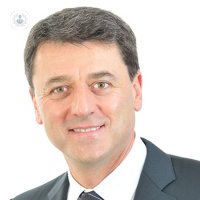What are multifocal lens implants, and who are they most suited for?
Written in association with:In this article below, multifocal lens implants are the topic of discussion as highly distinguished and experienced consultant ophthalmologist, Mr Vaughan Tanner, explains what multifocal lens implants are, and who they are best suited to.

What are multifocal lens implants?
The standard lens used in cataract surgery is a monofocal implant designed to provide patients with good vision at either near or distance, with glasses required for the rest of focused vision. Multifocal implants are designed to reduce the requirement for spectacles at more than one distance.
Most patients having either cataract surgery or refractive lens exchange would choose to be set predominantly for distance vision without glasses. The use of a multifocal implant or an extended depth of focus implant would then be aimed at decreasing the need for glasses to focus on intermediate vision (dashboard, large print, computer use) and near vision (reading smaller print).
Multifocal lenses aim to reduce the overall requirement for spectacles at all distances, but are associated with greater side effects than extended depth of focus implants, which aim to reduce requirement for distance and intermediate glasses.
Who are they most suited for?
Multifocal implants are only suitable in those with otherwise perfect eyes and whose eyes are prepared to tolerate the most common side effect of glare and halo around bright lights. Extended depth of focus implants are more forgiving in terms of side effects and are suitable for more people, including those with other minor eye problems.
How is extended depth of focus achieved?
Both multifocal and extended depth of focus implants work by splitting light energy into a distance, intermediate or near focus point. There have been great advances made recently, particularly in extended depth of focus implants.
My current implant of choice is the Alcon Vivity extended depth of focus implant. This uses what Alcon refer to as X-Wave technology to create two smooth surface transition elements on the surface of the lens that stretch and shift the wavefront of light.
This allows a wider range of focused image compared with a monofocal lens, helps decrease the need for spectacles, and avoids the side effects associated with stronger multifocal implants. Approximately 90 per cent of patients with the Vivity implant rarely or never need to wear glasses for distance and intermediate work, with around 50 per cent of patients not requiring glasses for near-distance work.
How long do they last?
Implants are usually lifelong with no requirement for replacement.
Are there any risks or side effects?
True multifocal implants (trifocal) are associated with visual disturbances such as glare, rings around headlights at night, starbursts, and some problems in dim lighting. However, the Vivity extended depth of focus implant has a much better side effect profile. In fact, the rate of visual disturbance with the Vivity implant is only very slightly higher than that seen in patients with a standard single focus lens.
If you are considering multifocal lens implants, don’t forget you can book a consultation with Mr Vaughan Tanner via his Top Doctors profile today.


